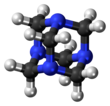| |||

| |||
| Names | |||
|---|---|---|---|
| Preferred IUPAC name
1,3,5,7-Tetraazaadamantane | |||
Other names
| |||
| Identifiers | |||
3D model (JSmol)
|
|||
| 2018 | |||
| ChEBI | |||
| ChEMBL | |||
| ChemSpider | |||
| DrugBank | |||
| ECHA InfoCard | 100.002.642 | ||
| EC Number |
| ||
| E number | E239 (preservatives) | ||
| 26964 | |||
| KEGG | |||
| MeSH | Methenamine | ||
PubChem CID
|
|||
| RTECS number |
| ||
| UNII | |||
| UN number | 1328 | ||
CompTox Dashboard (EPA)
|
|||
| |||
| |||
| Properties | |||
| C6H12N4 | |||
| Molar mass | 140.186 g/mol | ||
| Appearance | White crystalline solid | ||
| Odor | Fishy, ammonia like | ||
| Density | 1.33 g/cm3 (at 20 °C) | ||
| Melting point | 280 °C (536 °F; 553 K) (sublimes) | ||
| 85.3 g/100 mL | |||
| Solubility | Soluble in chloroform, methanol, ethanol, acetone, benzene, xylene, ether | ||
| Solubility in chloroform | 13.4 g/100 g (20 °C) | ||
| Solubility in methanol | 7.25 g/100 g (20 °C) | ||
| Solubility in ethanol | 2.89 g/100 g (20 °C) | ||
| Solubility in acetone | 0.65 g/100 g (20 °C) | ||
| Solubility in benzene | 0.23 g/100 g (20 °C) | ||
| Acidity (pKa) | 4.89[1] | ||
| Pharmacology | |||
| J01XX05 (WHO) | |||
| Hazards | |||
| Occupational safety and health (OHS/OSH): | |||
Main hazards
|
Highly combustible, harmful | ||
| GHS labelling: | |||
 
| |||
| Warning | |||
| H228, H317 | |||
| P210, P240, P241, P261, P272, P280, P302+P352, P321, P333+P313, P363, P370+P378, P501 | |||
| NFPA 704 (fire diamond) | |||
| Flash point | 250 °C (482 °F; 523 K) | ||
| 410 °C (770 °F; 683 K) | |||
Except where otherwise noted, data are given for materials in their standard state (at 25 °C [77 °F], 100 kPa).
| |||
Hexamethylenetetramine (HMTA), also known as 1,3,5,7-tetraazaadamantane, is a heterocyclic organic compound with diverse applications.[2][3] It has the chemical formula (CH2)6N4 and is a white crystalline compound that is highly water soluble in water and polar organic solvents. It has a cage-like structure similar to adamantane.[3] It is useful in the synthesis of other organic compounds, including plastics, pharmaceuticals, and rubber additives.[2][3] The compound is also used medically for certain conditions.[4][5] It sublimes in vacuum at 280 °C. The molecule has a tetrahedral cage-like structure, similar to that of adamantane. Four vertices are occupied by nitrogen atoms, which are linked by methylene groups. Although the molecular shape defines a cage, no void space is available at the interior.
- ^ Cooney AP, Crampton MR, Golding P (1986). "The acid-base behaviour of hexamine and its N-acetyl derivatives". J. Chem. Soc., Perkin Trans. 2 (6): 835–839. doi:10.1039/P29860000835.
- ^ a b Dreyfors JM, Jones SB, Sayed Y (November 1989). "Hexamethylenetetramine: a review". American Industrial Hygiene Association Journal. 50 (11): 579–585. doi:10.1080/15298668991375191. PMID 2688388.
- ^ a b c Blažzević, Nikola; Kolbah, D.; Belin, Branka; Šunjić, Vitomir; Kajfež, Franjo (1979). "Hexamethylenetetramine, A Versatile Reagent in Organic Synthesis". Synthesis. 1979 (3). Georg Thieme Verlag KG: 161–176. doi:10.1055/s-1979-28602. ISSN 0039-7881.
- ^ Cite error: The named reference
LoHammerZegarra2014was invoked but never defined (see the help page). - ^ Connolly M, de Berker D (2003). "Management of primary hyperhidrosis: a summary of the different treatment modalities". Am J Clin Dermatol. 4 (10): 681–697. doi:10.2165/00128071-200304100-00003. PMID 14507230.


